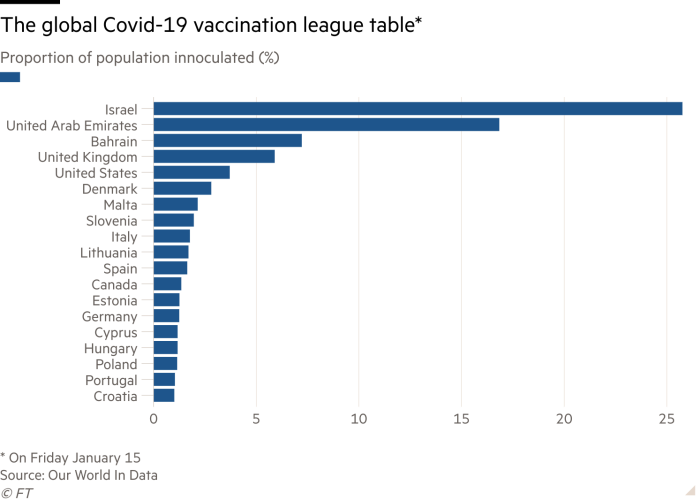The UK has pulled ahead of other large advanced economies in the race to vaccinate against coronavirus, and had inoculated almost 6 per cent of its population by the end of last week.
After performing poorly in controlling the spread of the virus, testing and tracing positive cases, preventing deaths and protecting the economy, Britain’s stronger effort in vaccinating its citizens is allowing ministers to dream that an end to Britain’s Covid-19 crisis might be in sight.
The success is because of a combination of strong planning, a willingness to spend and the centralised structure of the NHS.
With almost 1.8m first-dose jabs delivered last week and the pace of vaccination still increasing, Matt Hancock, health secretary, on Monday warned the nation to continue to adhere to lockdown restrictions.
He said: “Don’t blow it now. We’re on the route out. We’re protecting the most vulnerable. We’re getting the virus under control.”
Having vaccinated most of the over-80s in many regions, the country began inoculating the over-70s this week and is on track to meet its target of giving 15m first doses by February 15.

While Israel, Bahrain and the United Arab Emirates lead the world on the proportion of population that has been vaccinated, the UK comes fourth, ahead of the US and significantly higher than all other European countries. Denmark had inoculated 2.8 per cent of its population by the end of last week, less than half the UK’s 5.9 per cent rate on the same date.
Part of the reason for the UK’s relatively rapid progress is its willingness to loosen the purse strings to fight the pandemic. Having spent over £280bn, more than 14 per cent of national income, on all aspects of fighting the virus, the government has devoted £11.7bn to the purchase, manufacture and deployment of Covid-19 vaccines, and to support vaccine research, according to the UK’s National Audit Office.

Although the pricing of contracts around the world is not transparent, the UK appears to be paying a similar amount per dose as other countries.
The UK’s medicines regulator has approved three vaccines so far, with the government ordering 100m doses of the Oxford/AstraZeneca jab, developed and manufactured largely in Britain, which uses a harmless adenovirus as the carrier of coronavirus genes.
It has also ordered 40m doses of BioNTech/Pfizer’s mRNA vaccine, which carries a very similar set of coronavirus genes in lipid nanoparticles — microscopic droplets of oil.
The Moderna vaccine has been approved for emergency use, and the government has increased the number of doses on order to 17m — although they will not arrive until the spring.
The centralised structure of the NHS has strengthened the rollout of the vaccination programme, with the supply of vaccines the limiting factor, according to ministers.
“We have one consolidated system that functions under a command and control basis, and that’s the ideal way to implement an immunisation programme,” said David Salisbury, until 2013 the senior official in charge of immunisation for the UK government.
“I don’t think anyone could go much faster than the UK is going unless they had a bigger supply,” he added.
Prof Salisbury cautioned, however, that the system would be coming under fresh strain in two months, when the government started giving second doses as well as ramping up the numbers of people receiving their first jab.
But one industry figure with knowledge of government procurement praised planning around the vaccine programme, saying that the UK had months ago ordered syringes in bulk, while some other nations were only now scrambling to secure the vital equipment amid tough global competition for scarce supplies.

Not all aspects of the UK’s current strategy for Covid-19 are working smoothly, however. Positive case rates have been falling across the UK during the latest lockdown, which has seen schools closed for face-to-face lessons, but this has not yet spread to the most vulnerable adults over 80 years old.
In these groups, case rates actually rose in the most recent weeks, suggesting that the vaccination policy was not yet working to bring down numbers and that infections had spread again into care homes.
There are also worries that vaccines might be less effective against new strains of the virus, although this is not expected to be a significant problem for the B.1.1.7 strain that is becoming the dominant variant in the UK.
For now, the UK is pushing forward with its plan to vaccinate as many people as quickly as possible.
On the basis of a Scottish government vaccine deployment document which was hastily withdrawn last week to avoid revealing the UK’s likely supply of vaccines, the country hopes to be inoculating 500,000 people a day this week.

That would put the country on track to have given a first dose of the vaccine to 80 per cent of all the over-50s and vulnerable adults by early May — or 41m vaccinations to 60 per cent of the population. If it meets this target, second doses would be given by early July. This would allow the government to start vaccinating lower-risk groups.
While ministers hope the race to vaccinate will allow a rapid relaxation of the lockdown restrictions, some economists cautioned that the maths dictated that social distancing was more effective in bringing case numbers down quickly than a vaccination programme.
David Mackie, chief European economist at JPMorgan, estimated that if the vaccine rollout went as planned, the number of people in hospital would drop from almost 40,000 now to a little over 10,000 by April. However, if the number of contacts each person had fell to the level of the first lockdown last year, it would drop to just under 600.

